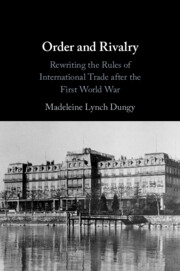Book contents
- Order and Rivalry
- Order and Rivalry
- Copyright page
- Dedication
- Contents
- Acknowledgements
- Organizational Abbreviations
- Introduction
- 1 Organizing Globalization
- 2 The World Economy at War
- 3 Planning the Peace
- 4 From Bilateral to Multilateral Trade Treaties
- 5 Studying the World Economy, from Kiel and from Geneva
- 6 European Unity and Security
- 7 The International Chamber of Commerce and the Politics of Business
- Conclusion
- Bibliography
- Index
5 - Studying the World Economy, from Kiel and from Geneva
Published online by Cambridge University Press: 01 June 2023
- Order and Rivalry
- Order and Rivalry
- Copyright page
- Dedication
- Contents
- Acknowledgements
- Organizational Abbreviations
- Introduction
- 1 Organizing Globalization
- 2 The World Economy at War
- 3 Planning the Peace
- 4 From Bilateral to Multilateral Trade Treaties
- 5 Studying the World Economy, from Kiel and from Geneva
- 6 European Unity and Security
- 7 The International Chamber of Commerce and the Politics of Business
- Conclusion
- Bibliography
- Index
Summary
After Llewellyn Smith initially set the League Economic Committee on a cautious course, Franco-German conflict helped stimulate the development of a more ambitious trade agenda that found expression in the League’s 1927 World Economic Conference. Bernhard Harms participated by demanding a more broadly institutionalized international economic regime that would include the United States and would cover sensitive issues skirted by Llewellyn Smith, including reparations, raw materials, and colonial markets. Harms had a prominent bully pulpit from which to promote this vision, as the director of the IfW. He used his position to facilitate ongoing policy dialogue among a large community of League collaborators and critics. He helped establish a novel think-tank environment that spanned business, academia, and government and became an important base of support for the League. In recognition of his pivotal role in international information networks, Harms was asked to coordinate a massive economic bibliography for the League at the end of the 1920s, with backing from US philanthropic societies. This abortive project revealed the limits of Harms’s strategy of transatlantic outreach.
Keywords
- Type
- Chapter
- Information
- Order and RivalryRewriting the Rules of International Trade after the First World War, pp. 152 - 184Publisher: Cambridge University PressPrint publication year: 2023

